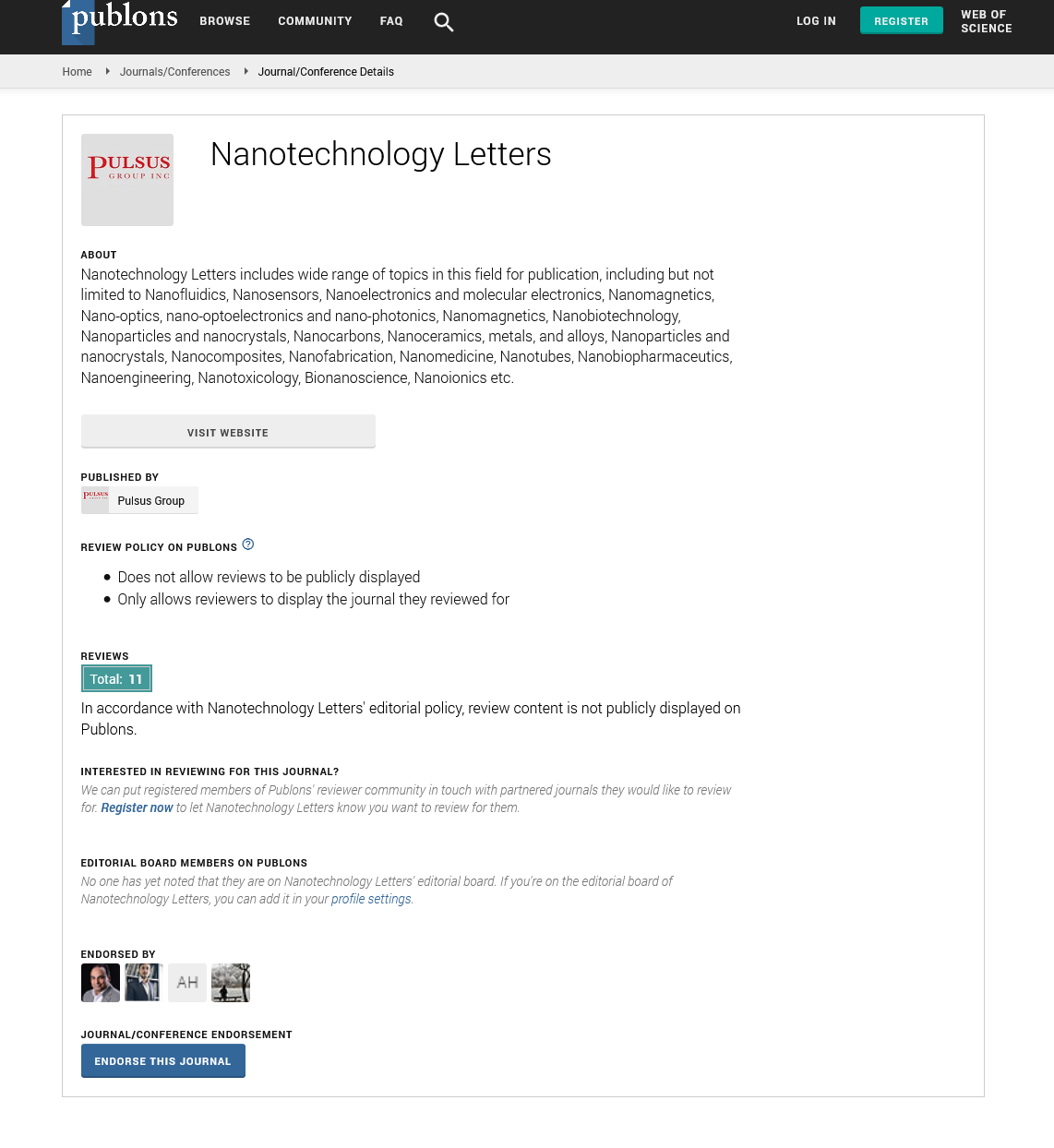Nanotechnology uses in rice cultivation
Received: 01-Mar-2022, Manuscript No. pulnl-22-4902; Editor assigned: 04-Mar-2022, Pre QC No. pulnl-22-4902(PQ); Reviewed: 17-Mar-2022 QC No. pulnl-22-4902(Q); Revised: 24-Mar-2022, Manuscript No. pulnl-22-4902(R); Published: 28-Mar-2022, DOI: 10.37532.pulnl.22.7.2.1-2
Citation: Hoffman A. Nanotechnology uses in rice cultivation. Nanotechnol Lett. 2022; 7(2):1-2.
This open-access article is distributed under the terms of the Creative Commons Attribution Non-Commercial License (CC BY-NC) (http://creativecommons.org/licenses/by-nc/4.0/), which permits reuse, distribution and reproduction of the article, provided that the original work is properly cited and the reuse is restricted to noncommercial purposes. For commercial reuse, contact reprints@pulsus.com
Abstract
Magnaporthe oryzae, the rice blast fungus, is one of the most damaging diseases of cultivated rice in the world, posing a severe danger to rice production. Regrettably, neither traditional breeding nor chemical approaches to control it are effective. Nanotechnology has lately been explored as a potential new safer pesticide, and silica nanoparticles (SiO2 NPs) have been suggested as a potential new safer agrochemical, although systematic investigations, particularly in rice, remain scarce.
Introduction
Silica nanoparticles (SiO2 NPs) have been proposed for the controlled nanodelivery of silicon and other active substances to plants, although extensive testing has yet to be done. Additionally, silicon has been discovered to be beneficial to plant growth and to assist plants in overcoming biological and abiotic challenges. Rice is a silicon-loving crop because it can absorb and store huge amounts of silicon at a greater level (up to 10%) of shoot dry weight, which is several times higher than critical macronutrients like nitrogen, potassium, and phosphate. Traditional silicon has been discovered to prevent M. oryzae infection by not only producing a physical barrier to fungal penetration in the leaves and stems due to the precipitation of biogenic opaline silicon in the epidermis, but also by amplifying the host's molecular-scale defences. Thus, more research on whether SiO2 NPs can help rice grow and resist diseases without causing significant harm is needed, but the results are still uncertain.
SiO2 NPs have been shown to induce local and systemic disease resistance in Arabidopsis thaliana against the bacterial pathogen Pseudomonas syringe in a recent study. However, there is still a dearth of specific mechanistic understanding of the underlying processes and how they act on major crops. We discovered that SiO2 NPs might activate plant immunity to improve rice resistance to the rice blast fungus through foliar application at an optimal concentration range in this study.
Furthermore, this SA-dependent fungal resistance might be obtained via root treatment via a SAR method, resulting in a more plantfriendly friendly version with no phytotoxicity. Surprisingly, root treatment with SiO2 NPs also improved rice seedling root development, resulting in higher water absorption and a superior drought response. To begin with, our findings identified SiO2 NPs as a potentially effective and safe method for protecting rice against biological and abiotic stress in the context of rapidly rising grain demand and climate change. Lastly, we preliminarily identified the pathways by which different treatment techniques resulted in different rice resistance effects.
The issues confronted by plant pathologists and other agriculturalists appear to be extremely intimidating, especially when considering the production loss caused by plant disease. Recently, nanotechnology has begun to be viewed as a new weapon in our armoury in the fight against disease control's growing challenges. However, nanotechnology's application in plant disease management is still in its early stages, and the specific molecular pathways are mostly unknown. Silica nanoparticles (SiO2 NPs) have recently been recognised as one of the prospective new safer agrochemicals, despite the lack of systematic investigations and a clear mechanism, particularly in key crops. Through activating plant SA signalling, SiO2 NPs may improve its resistance to the rice blast fungus M. oryzae.
SA buildup and SAR response are involved in the resistance of rice leaves to M. oryzae induced by root treatment. Salicylic Acid (SA) is an essential plant hormone for plant immunity, including hypersensitive reactions and SAR. Because of the overexpression of SA-responsive genes as well as the inhibition of induced resistance in SA mutants, SiO2 NP-induced resistance to M. oryzae is mostly dependent on SA signalling. Moreover, the disorganised intake under 3000 mg/l of foliar therapy caused chaos in SA-related regulation, worsening the sickness. Although a recent study in A. thaliana demonstrated that SiO2 NPs can enhance SAR between local and systemic leaves.
SiO2 NPs were found to enhance rice resistance to M. oryzae by stimulating plant immunity via the SA-dependent pathway, and root treatment was found to be the most effective and safe application method due to its reduced phytotoxicity risk and promotion of root development and water absorption in the face of adversity. Since amorphous SiO2 NPs have been used as dietary additives (E551) in a variety of foodstuffs such as table salt, they are usually recognised as a safe element.






